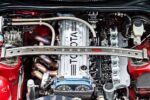Does a Diesel Engine Have a Catalytic Converter?
When you pop the hood of a diesel engine, you might wonder about all the components working together to make that beast roar. One question that often comes up is whether diesel engines come equipped with a catalytic converter. For many gearheads and everyday drivers alike, understanding this piece of equipment can be the difference between a smooth ride and a trip to the repair shop. Let’s break it down.
The Basics of Diesel Engines
Diesel engines are known for their durability and fuel efficiency, primarily used in heavy-duty applications like trucks, buses, and industrial machinery. Unlike gasoline engines, which use spark plugs to ignite a fuel-air mixture, diesel engines rely on compression to ignite the fuel. This fundamental difference in operation leads to unique emissions profiles.
While gasoline engines have been using catalytic converters for decades to control harmful emissions, the diesel engine landscape is a bit different. The emissions from diesel engines include nitrogen oxides (NOx) and particulate matter (soot), which are not only harmful to the environment but also regulated by law. As a result, the automotive industry has had to adapt and innovate.
What About Catalytic Converters?
So, do diesel engines have catalytic converters? The straightforward answer is: it depends. Traditional diesel engines often do not come with catalytic converters like their gasoline counterparts. Instead, they utilize different technologies to manage emissions. However, with tightening regulations and growing environmental concerns, many modern diesel engines are being equipped with advanced emission control systems that may include catalytic converters, specifically designed to handle the unique challenges posed by diesel emissions.
These systems often work in conjunction with other components such as diesel particulate filters (DPFs) and selective catalytic reduction (SCR) systems. Understanding these technologies is crucial for anyone looking to maintain or modify a diesel engine.
In the following sections, we’ll dig deeper into the specifics of how these systems work and what you need to know as a diesel owner or enthusiast.
Understanding Diesel Emissions and Catalytic Converters
When it comes to diesel engines, the conversation around emissions and the use of catalytic converters is crucial. Diesel engines have long been associated with higher levels of nitrogen oxides and particulate matter compared to gasoline engines. This has led to a variety of technologies being developed to meet stringent emissions regulations. Let’s explore whether diesel engines have catalytic converters and how they work alongside other emission control technologies.
Do Diesel Engines Have Catalytic Converters?
The short answer is that many modern diesel engines do have catalytic converters, but they are not the same as those found in gasoline engines. Here’s a breakdown of the different scenarios:
| Engine Type | Catalytic Converter | Emission Control Technologies |
|---|---|---|
| Older Diesel Engines | Typically No | Mechanical systems (like turbochargers), but no catalytic converters. |
| Modern Diesel Engines | Yes | Includes catalytic converters, DPFs, SCR systems. |
Older Diesel Engines
Most older diesel engines, particularly those manufactured before the 2000s, did not come equipped with catalytic converters. Instead, they relied on mechanical systems to manage emissions. These engines produced higher levels of soot and NOx, which often led to environmental concerns and regulatory scrutiny.
Modern Diesel Engines
Fast forward to today, and the landscape has changed significantly. Modern diesel engines are often fitted with advanced emission control systems that include:
-Catalytic Converters: Specifically designed for diesel engines, these converters help reduce NOx emissions.
-Diesel Particulate Filters (DPFs): These filters capture soot and particulate matter, preventing them from being released into the atmosphere.
-Selective Catalytic Reduction (SCR): This system uses a urea-based solution (commonly known as diesel exhaust fluid or DEF) to convert NOx into harmless nitrogen and water.
How Do Diesel Catalytic Converters Work?
Diesel catalytic converters function differently than those in gasoline engines. They typically use a combination of oxidation and reduction reactions to convert harmful pollutants. Here’s how it works:
1. Oxidation: The catalytic converter oxidizes carbon monoxide (CO) and unburned hydrocarbons (HC) into carbon dioxide (CO2) and water (H2O).
2. Reduction: The SCR system reduces NOx emissions by injecting DEF into the exhaust stream. The heat from the exhaust facilitates a chemical reaction that converts NOx into nitrogen and water.
Types of Catalytic Converters in Diesel Engines
There are primarily two types of catalytic converters used in diesel engines:
-Lean NOx Trap (LNT): This type captures NOx during lean burn conditions and releases it during rich conditions.
-Diesel Oxidation Catalyst (DOC): This is used primarily to oxidize CO and HC, and is often found in conjunction with DPF systems.
Regulatory Impact on Diesel Emissions
The introduction of stricter emissions regulations has played a significant role in the adoption of catalytic converters in diesel engines. Countries around the world have implemented standards that require diesel engines to meet specific NOx and particulate matter limits. Here’s a quick overview of some major regulations:
- EPA Standards (USA): The Environmental Protection Agency has set stringent limits for diesel emissions, necessitating advanced technologies.
- EU Emission Standards: The European Union has progressively tightened emissions standards, leading to widespread adoption of emission control technologies in diesel vehicles.
- Global Initiatives: Many countries are following suit, implementing regulations that push for cleaner diesel technologies.
Maintenance Considerations
For diesel owners, understanding the importance of these components is crucial for maintenance. Catalytic converters, DPFs, and SCR systems require regular checks to ensure they are functioning correctly. Neglecting these components can lead to increased emissions and potential engine damage. Here are some maintenance tips:
- Regularly check and replace the diesel exhaust fluid (DEF) as needed.
- Inspect the DPF for blockages and clean or replace it when necessary.
- Monitor the performance of the catalytic converter to ensure it’s not clogged or damaged.
In summary, while traditional diesel engines typically did not have catalytic converters, modern diesel technology has evolved to include them as part of a comprehensive approach to emissions control. Understanding these systems is essential for anyone involved with diesel engines, whether for maintenance, modification, or simply to stay informed about environmental impacts.




0 Comments